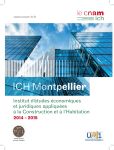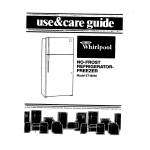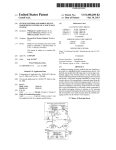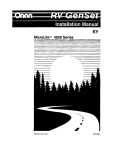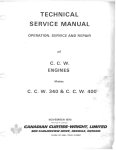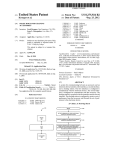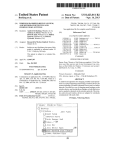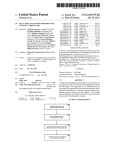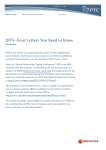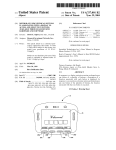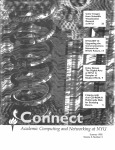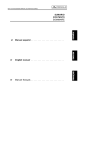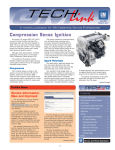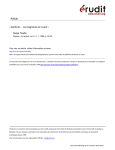Download Mobile device base station
Transcript
US008463238B2 (12) United States Patent (10) Patent No.: Forstall et al. (54) (45) Date of Patent: MOBILE DEVICE BASE STATION 5,031,104 A 5,067,081 A (75) Inventors: Scott Forstall, Mountain View, CA 531953031 A CA (US); Robert E. Borchers, Pleasanton, CA (U S); Kevin Tiene, cupemno CA (Us) 5,243,652 A 5,337,044 A 5,371,678 A ’ . . 7/1991 Ikeda et a1. @ggggma et al 3/1993 Ordish 9/1993 Teare 8/1994 Folger et a1. 12/1994 Nomura 5,379,057 A 1/1995 Clough et a1. 5,406,490 A 4/1995 5,416,890 A 5,469,362 A Notice: Filed, 11/1995 Hunt et a1. Subject to any disclaimer, the term of this patent is extended or adjusted under 35 5,519,760 A 5,523,950 A 5/1996 Borkowski et a1, 6/1996 Peterson U.S.C. 154(b) by 1261 days. 5,537,460 A 7/1996 Holliday, Jr. et a1. 5,539,395 A 7/1996 Buss (Continued) Jan 2 2008 . . (65) FOREIGN PATENT DOCUMENTS , Prior Publication Data Us 2009/0005005 A1 BR 9904979 12/2000 CA 2163215 5/1994 Jan. 1, 2009 (Commued) Related US. Application Data (60) Provisional application No. 60/946,788, ?led on Jun. OTHER PUBLICATIONS U'S' Appl' NO' ll/464’67l’ ?led Aug' 15’ 2006’ Johnson 28, 2007. (51) glgllgll'l/mi (52) U S Cl B 5/1995 B2238 (21) Appl. No.: 11/968,609 (22) Jun. 11, 2013 11/1991 Person 2 (US); Gregory N. Christie, San Jose, (73) Ass1gnee: Apple Inc., Cupertmo, CA (US) (*) US 8,463,238 B2 (Continued) (2006 01) ' Primary Examiner * Sharad Rampuria (74) Attorney, Agent, or Firm * GaZdZinski & Associates, USPC ..... .. 455/411; 455/426.1; 455/557; 455/41.2; PC 455/418; 455/456.4; 370/338 (58) Field of Classi?cation Search USPC """ S 34:12:‘ 1, _ ?l If ’ 1' ’ ' I; h, ’ ee app lcanon e or Comp ete Seam lstory' (56) References Cited U.S. PATENT DOCUMENTS 2/1987 Zabarsky et a1. 4,644,351 A 4,903,212 A 2/1990 Yokouchi et a1. (57) ABSTRACT A mobile device can be con?gured as a base station to be used by other mobile devices and non-mobile devices to gain access to network services. The mobile device can be con?g ured to provide and manage secure access to variety of net works (e.g., Wi-Fi, WiMaX, Internet, cellular) and network services (e.g., map services, web services, syncing services). 19 Claims, 5 Drawing Sheets US 8,463,238 B2 Page 3 2002/0035609 A1 2002/0042266 A1 3/2002 Lessard et al. 4/2002 HeyWard et al. 2007/0073480 A1 2007/0073719 A1 3/2007 Singh 3/2007 Ramer et al. 2002/0046069 A1 2002/0046077 A1 4/2002 MoZayeny et al. 4/2002 MoZayeny et al. 2007/0082655 A1* 2007/0083470 A1 * 4/2007 Link et al. ................... .. 455/410 4/2007 Bonner et al. ................ .. 705/51 2002/0046084 2002/0091991 2002/0140560 2002/0160815 A1 A1 A1 A1 4/2002 7/2002 10/2002 10/2002 Steele et al. Castro Altman et al. Patel et al. 2007/0093258 2007/0106465 2007/0115868 2007/0117451 A1 A1 A1 A1 4/2007 5/2007 5/2007 5/2007 Steenstra et al. Adam et al. Chen et al. Yokoyama 2002/0167442 2003/0069683 2003/0100326 2003/0101225 2003/0134657 2003/0144793 2003/0236106 A1 A1 A1 A1 A1 A1 A1 11/2002 Taylor 4/2003 Lapidot et al. 5/2003 Grube et al. 2007/0124043 2007/0124066 2007/0129888 2007/0130153 2007/0135136 2007/0135990 2007/0149212 A1 A1 A1 A1 A1 A1 A1 5/2007 5/2007 6/2007 6/2007 6/2007 6/2007 6/2007 Ayoub et al. Kikuchi Rosenberg Nachman et al. Ische Seymour et al. Gupta et al. 5/2003 7/2003 7/2003 12/2003 Han et al. Norta et al. Melaku et al. Master et al. 2004/0036649 A1 2/2004 Taylor 2007/0150320 A1 6/2007 Huang 2004/0054428 A1 3/2004 Sheha et al. 2007/0153983 A1 7/2007 Bloebaum et al. 2004/0082351 A1 4/2004 Westrnan .................... .. 455/518 2007/0153984 A1 7/2007 Bloebaum et al. 2004/0128067 2004/0151151 2004/0158401 2004/0158584 2004/0172409 A1 A1 A1 A1 A1 7/2004 8/2004 8/2004 8/2004 9/2004 Smith Kubler et al. Yoon Necsoiu et al. James 2007/0153986 2007/0156326 2007/0179854 2007/0204218 2007/0206730 A1 A1 A1 A1 A1 7/2007 7/2007 8/2007 8/2007 9/2007 2004/0176907 2004/0198379 2004/0203836 2004/0203909 A1 A1 A1 A1 A1 A1 A1 A1 A1 A1 A1 A1 A1 A1 A1 A1 A1 A1 A1 A1 A1 A1 A1 A1 A1 A1 A1 A1 A1 A1 A1 A1 A1 A1 A1 A1 A1 9/2004 10/2004 10/2004 10/2004 11/2004 11/2004 12/2004 12/2004 12/2004 12/2004 12/2004 1/2005 1/2005 2/2005 4/2005 5/2005 5/2005 7/2005 7/2005 9/2005 10/2005 10/2005 10/2005 10/2005 10/2005 10/2005 11/2005 12/2005 1/2006 2/2006 2/2006 2/2006 2/2006 3/2006 4/2006 5/2006 5/2006 Nesbitt Magee et al. Gorday et al. Koster 2007/0219706 2007/0232326 2007/0233387 2007/0254676 Kubler et al. Bickford et al. Luneau Kubler et al. Patel et al. IchikaWa et al. Kubler et al. Doviak et al. PerkoWski et al. 2007/0260751 2007/0271328 2007/0276586 2007/0276587 2007/0276596 2007/0282521 2007/0299601 2008/0004802 2008/0005104 Kelley et al. 2008/0005301 Anderson et al. Simske Krull et al. Isaac Hanson Nortrup Karlsson et al. Friedman et al. Davis et al. Chang et al. Hamynen et al. Kim et al. Zhou et al. Janacek Gieseke Johnson Leblanc et al. Jung et al. Cheng et al. Mehren Wang et al. Neilson et al. Carlsan et al. 2008/0015422 2008/0021632 2008/0024360 2008/0024364 2008/0027636 2008/0030308 2008/0032703 2008/0045234 2008/0052407 2008/0070593 2008/0071466 2008/0082254 2008/0085727 2008/0086240 2008/0091347 2008/0097698 2008/0098090 2008/0104634 2008/0109153 2008/0113672 2008/0129528 2008/0132243 2008/0132251 A1 A1 A1 A1 A1 A1 A1 A1 A1 A1 A1 A1 A1 A1 A1 A1 A1 A1 A1 A1 A1 A1 A1 A1 A1 A1 A1 A1 A1 A1 A1 A1 A1 A1 A1 A1 A1 9/2007 10/2007 10/2007 11/2007 11/2007 11/2007 11/2007 11/2007 11/2007 12/2007 12/2007 1/2008 1/2008 1/2008 1/2008 1/2008 1/2008 1/2008 1/2008 2/2008 2/2008 2/2008 2/2008 3/2008 3/2008 4/2008 4/2008 4/2008 4/2008 4/2008 4/2008 5/2008 5/2008 5/2008 6/2008 6/2008 6/2008 2004/0228330 2004/0236504 2004/0242149 2004/0246940 2004/0248586 2004/0260939 2004/0264442 2005/0002419 2005/0004838 2005/0027442 2005/0085272 2005/0096840 2005/0114021 2005/0149250 2005/0153681 2005/0197767 2005/0221808 2005/0221843 2005/0222756 2005/0227709 2005/0228860 2005/0239477 2005/0250440 2005/0286421 2006/0015249 2006/0022048 2006/0025158 2006/0041377 2006/0041378 2006/0058955 2006/0085392 2006/0094353 2006/0111122 2006/0172769 A1 2006/0180649 2006/0184978 2006/0195481 2006/0202819 2006/0211453 2006/0218209 2006/0229802 2006/0284767 2006/0287824 2007/0001875 2007/0005188 2007/0005233 2007/0010942 2007/0016362 2007/0042790 2007/0055684 2007/0061245 2007/0061363 A1 A1 A1 A1 A1 A1 A1 A1 A1 A1 A1 A1 A1 A1 A1 A1 A1 A1 8/2006 Oh .............................. .. 455/557 8/2006 8/2006 8/2006 9/2006 9/2006 9/2006 10/2006 12/2006 12/2006 1/2007 1/2007 1/2007 1/2007 1/2007 2/2007 3/2007 3/2007 3/2007 Casey Casey Arrouye et al. AdamcZyk et al. Schick Arrouye et al. Vertelney et al. Taylor Lin Taylor Johnson Pinkus et al. Bill Nelson Mohi et al. Stevens Ramer et al. Ramer et al. 2008/0132252 A1 2008/0140308 2008/0140520 2008/0153512 2008/0153513 2008/0155453 2008/0161034 2008/0167083 2008/0167811 2008/0172173 2008/0172374 2008/0176545 2008/0177793 2008/0189033 2008/0249667 2008/0271072 2008/0318550 2009/0003659 2009/0005018 A1 A1 A1 A1 A1 A1 A1 A1 A1 A1 A1 A1 A1 A1 A1 A1 A1 A1 Bloebaum et al. Nesbitt Ziv et al. Weber et al. Polk Sheynblat Johnson Johnson Pedigo et al. Meesseman Geelen et al. Jeon et al. Johnson Solomon et al. Broughton Zhao et al. HorvitZ Flake et al. Li et al. Wessel Amano Taylor Taylor Tengler et al. Johnson Krumm et al. Reed Baudino et al. Altman et al. Downs et al. Huhtala et al. KratZ Breed Tashiro Arnold-Huyser et al. Geraci et al. Gajdos et al. GueZiec Karr et al. Guthrie Spalink et al. Altman et al. 6/2008 Altman et al. 6/2008 6/2008 6/2008 6/2008 6/2008 7/2008 7/2008 7/2008 7/2008 7/2008 7/2008 7/2008 8/2008 10/2008 10/2008 12/2008 1/2009 1/2009 Yamane et al. Hyder et al. Kale et al. Flake et al. Othmer Akiyama Wyld et al. Geelen Chang et al. Wolosin et al. Dicke et al. Epstein et al. Geelen et al. HorvitZ et al. Rothschild et al. DeAtley Forstall et al. Forstall et al. US 8,463,238 B2 Page 4 2009/0005021 2009/0005068 2009/0005070 2009/0005071 2009/0005072 2009/0005076 2009/0005080 2009/0005082 2009/0005964 2009/0005965 2009/0005975 2009/0005978 2009/0005981 2009/0006336 A1 A1 A1 A1 A1 A1 A1 A1 A1 A1 A1 A1 A1 A1 1/2009 1/2009 1/2009 1/2009 1/2009 1/2009 1/2009 1/2009 1/2009 1/2009 1/2009 1/2009 1/2009 1/2009 Forstall Forstall Forstall Forstall Forstall Forstall Forstall Forstall Forstall Forstall Forstall Forstall Forstall Forstall et et et et et et et et et et et et et et al. al. al. al. al. al. al. al. al. al. al. al. al. al. JP JP JP JP JP JP JP JP JP KR KR TW W0 W0 2007-127439 2007-147439 2007-201699 2007-240400 2007-259291 2007-271299 2007-304009 2008-058917 2008-129774 2004-102440 2005-096746 200426387 WO 93/20546 WO 97/07467 5/2007 6/2007 8/2007 9/2007 10/2007 10/2007 11/2007 3/2008 6/2008 12/2004 10/2005 12/2004 10/1993 2/1997 2009/0017790 A1* 1/2009 Thalapaneni et al. ...... .. 455/410 W0 WO 97/24577 7/1997 2009/0030605 A1 2009/0031006 A1 2009/0033540 A1 1/2009 Breed 1/2009 Johnson 2/2009 Breed et al. W0 W0 W0 WO 98/03951 WO 98/07112 WO 98/54682 1/1998 2/1998 12/1998 2009/0058822 A1* 3/2009 Chaudhri .................... .. 345/173 W0 WO 99/16036 4/1999 2009/0089706 A1 2009/0098857 A1 2009/0177385 A1 4/2009 Furches et al. 4/2009 DeAtley 7/2009 Matas et al. W0 W0 W0 WO 99/44183 WO 01/37597 W0 02/054813 9/1999 5/2001 7/2002 2009/0247122 A1* 10/2009 Fitzgerald et a1. .......... .. 455/410 W0 W0 03/023593 3/2003 2009/0259573 2009/0271271 2009/0281724 2009/0286549 10/2009 10/2009 11/2009 11/2009 W0 W0 W0 W0 W0 W0 W0 03/096055 WO 2004/008792 WO 2004/021730 WO 2004/061576 WO 2004/076977 WO 20057006258 11/2003 V2004 3/2004 7/2004 9/2004 1/2005 A1 A1 A1 A1 Cheng et al. Johnson Blumenberg et al. SaZegari et al. FOREIGN PATENT DOCUMENTS CA 2287596 4/2000 $8 $853833)??? 135382 CA DE DE DE DE 2432239 4437360 19506890 19914257 10 141 695 12/2004 4/1996 8/1996 “999 3/2003 W0 W0 W0 W0 WO W0 W0 W0 5/2007 5/2008 7/2008 11/2009 2007/052285 2008/051929 2008/085740 2009/140031 EP 785535 7/1997 EP 0 809117 11/1997 EP EP 0 699 330 0 908 835 4/1998 4/1999 U.S. Appl. No. 12/044,363, ?led Mai. 37, 2008, Johnson. “New program for mobile blogging for Pocket PC released: My EP 1 457 928 90004 Internet URL: http://msmobiles.com/news.php/4067.html; 1 page. Ep EP EP EP 1 1 1 1 5; g; EP FR FR FR GB GB JP JP JP JP JP JP OTHER PUBLICATIONS Blog,” [online] [Retrieved on Apr. 5, 2006]; Retrieved from the 287 338 956 041 10/2004 1/2005 9/2005 2/2006 1 860 904 2730083 2272911 2810183 2 3 59 888 2 407 230 62142215 05-071974 06-525189 2007'22l433 9'062993 110007 8/1996 6/l999 l2/200l 5 /2()()1 4/2005 6/1987 3/1993 5/1994 5/1994 7/1997 i 469 496 770 465 g “Numbering and Dialing Plan Within the United States,”Alliancefor Telecommunications Industry Solutions, 2005, 17 pages. Dalrymple, “Google Maps adds locator, but not for iPhone,” [online] [Retrieved Nov. 30, 2007]; Retrieved from the Internet URL: http:// news.yahoo.com/s/macworld/20071130/tcimacworld/ googlemaps20071130i0&printer:1;iylt:Auvf3s6LQKi pOaJlb954TiDQn6gB; 1 page. Maxwell et al., “Alfred: The Robot Waiter Who Remembers You,” AAAI Technical Report WS-99-15, I999, 12 pages. Shibata et al., “Development and Integration of Generic Components for a Teachable Vision-Based Mobile Robot,” IEEE/ASME Transac tions on Mechatronics, 1996, 1(3):230-236. Wu et al., “A Multimedia System for Route Sharing andVideo-Based Navigation,” IEEE, 2006, pp. 73-76. Yogesh C. Rathod, Third Party Submission in US. Appl. No. 12/233,358 mailed Mai. 30, 2010, 12 pages. JP ll_234736 9-210710 8/1997 8/1999 Feddema it al., Cooperatlve Sentry Vehlcles and Dlfferentlal GPS JP 2000463379 60000 Leapfrog, 2000, Unlted States Department of Energy, pp. 1-12. Jp JP JP JP JP JP JP JP 2002310680 10.030933 2003-228532 2004-045054 2004419146 2004662271 2005406741 2005482146 10/2002 2/2003 8/2003 2/2004 7/2004 12/2004 4/2005 7/2005 JP 2005441519 2006412338 40006 JP JP Jp JP JP JP 2006484007 2006_270889 2006_279838 2007-033220 2007-033331 2007-033368 70006 10/2006 10/2006 2/2007 2/2007 2/2007 JP 9/2005 “ . . . . U.S. Appl. No. 11/972,559, ?led Jan. 10, 2008, Alten. US. Appl. No. 12/044,363, ?led Mar. 7, 2008, Johnson. U.S. Appl. No. 11/114,714, ?led May 2, 2008, Williamson et al. U.S. Appl. No. 12/119,316, ?led May 12, 2008, Blumenberg et al. U.S. Appl. No. 12/122,339, ?led May 16, 2008, SaZegari et al. U.S. Appl. No. 12/233,358, ?led Sep. 18, 2008, Low et al. U.S. Appl. No. 12/270,814, ?led Nov. 13, 2008, HerZ. “27 Countries in your pocket”; [online] [Retrieved on Sep. 29, 2005] R n‘ e leve d f rom th e I t n erne t <URL' lin ~// . ' -t hb/ p. www.mlo ec . e en / prlntvlew/press-releases-2005-09-29.htm; 1 page. “Animated Transition”; [online] [Retrieved on Oct. 16, 2006] Retrieved from the Internet <URL: http://designinterfaces.com/Ani matediTransition; 2 pages “DaimlerCrysler Guide5 Usecases Overview Map”, 1 page (no ref erence date). US 8,463,238 B2 Page 5 “International Roaming GuideiPersonal EXperience(s) from Cus tomer and Community Member”; [online] [Retrieved Jun. 26, 2006] Retrieved from the Internet <URL: http://forums.cingular.com/cng/ board/message?board.id:1185; 6 pages. “Mio 269+ Users Manula”; 2005; 44 pages. Review Guide4Google Maps for mobile (beta); Google; 2006; 7 GPS 12 Personal Navigator Owner ’s Manual & Reference, Garmin Corporation, Jan. 1999, pp. 1-60. Guo et al., “An Intelligent Query System based on Chinese Short Message Service for Restaurant Recommendation”, IEEE 2007, 1 page. pages. Hameed et al., “An Intelligent Agent-Based Medication and Emer gency System”, IEEE 2006. “User-centered design of mobile solutions”, NAMAHN, 2006, 18 Helal et al., “Drishti: An Integrated Navigation System for Visually pages. Impaired and Disabled”, Fifth International Symposium on Wearable “User’s Manual MioMap 2.0”; Aug. 2005; 60 pages. “Windows Live Search for Mobile Goes Final, Still Great”; [online] [Retrieved on Mar. 11, 2007]; Retrieved from the Internet, URL: Computers (ISWC’01), IEEE, 2001, pp. 149-156. Hohman et al., “GPS Roadside Integrated Precision Positioning Sys tem”, Position Location and Navigation Symposium (IEEE 2000), http://giZmodo .com/gadgets/software/windows-live-search-for-mo pp. 221-230. bile-goes-?nal-still-great-236002.php; 3 pages. “Windows Mobile 6 Professional Video Tour”; [online] [Retrieved on Mar. 11, 2007]; Retrieved from the Internet, URL: http://giZmodo. International Numbering and SMSiType of Numbering, TON, Numbering Plan Indicator, NPI, [online] [Retrieved Jan. 5, 2007] Retrieved from the Internet <URL: http://wwwactiveexpertscom/ com/gadgets/cellphones/windows-mobile-6-professional-video support/activ sms/tonnpi/ . tour-237039.php; 4 pages. “Windows Mobile”; Microsoft; 2007, 2 pages. Anand et al., “Quantitative Analysis of Power Consumption for Loca tion-Aware Applications on Smart Phones”, IEEE International Syrn posium on Industrial Electronics, 2007. Beard et al., “Estimating Positions and Paths of Moving Objects”, Jirawimut et al., “A Method for Dead Reckoning Parameter Correc tion in Pedestrian Navigation System”, IEEE Transactions on Instru mentation and Measurement, vol. 52, No. 1, Feb. 2003, pp. 209-215. Ju et al., “RFID Data Collection and Integration based on Mobile IEEE 2000, pp. 1-8. Strength and Time of Arrival”, IEEE, 2005. Koide et al., “3 -D Human Navigation System with Consideration of Neighboring Space Information”, IEEE International Conference on Bederson, B.B., Audio Augmented Reality: A Prototype Automated Tour Guide [online] [retrieved on Aug. 30, 2002] [retrieved from http://www.cs.umd.edu/~bederson/papers/chi-95-aar/] pp. 1-4. Berman et al., “The Role of Dead Reckoning and Inertial Sensors in Future General Aviation Navigation”, IEEE, 1998, pp. 510-517. Bevly et al., “Cascaded Kalman Filters for Accurate Estimation of Multiple Biases, Dead-Reckoning Navigation, and Full State Feed back Control of Ground Vehicles”, IEEE Transactions on Control Systems in Technology, vol. 15, No. 2, Mar. 2007, pp. 199-208. BinZhuo et al., “Mobile Phone GIS Based on Mobile SVG”, IEEE 2005. Bokharouss et al., “A Location-Aware Mobile Call Handling Assis tant”, International Conference on Advanced Information Network ing and Applications Workshops, 2007. Boonsrimuang et al., “Mobile Internet Navigation System”, IEEE, Agent”, IEEE, 2006. Kbar et al., “Mobile Station Location based on Hybrid of Signal Systems, Man and Cybernetics, 2006 (SMC ’06), vol. 2, (Oct. 8-11, 2006), pp. 1693-1698. Lloyd et al., “Cellular phone base stations installation violate the Electromagnetic Compatibility regulations”, IEEE, 2004. Manabe et al., “On the M-CubITS Pedestrian Navigation System”, IEEE, 2006, pp. 793-798. Meier et al., “Location-Aware Event-Base Middleware: A Paradigm for Collaborative Mobile Applications?”, Sep. 2003. Miller et al., “Synchronization of Mobile XML Databases by UtiliZ ing Deferred Views”, IEEE 2004. Nardi et al., “Integrating Communication and Information through Contact Map”, Communications of the ACM, vol. 45, No. 4, Apr. 2002, pp. 325-328. 2002. Camp et al., “A computer-based method for predicting transit time systems”, Decsision Sciences, vol. 5, pp. 339-346, 1974. Carew; “Phones that tell you where to drive, meet, eat”; [online] [Retrieved May 26, 2007]; Retrieved from the Internet <URL httlp:// Northard, “Docking Station Communication Link”, IBM TDB, Feb. news.yahoo.com/s/nm/20070525/wrinm/columnipluggedini dci2&printer:1;iylt:Ahqaftn7Xm1S2r0FZFeu9G4ht.cA; 2 pages. Cho et al., A Traveler Information Service Structure in Hybrid T-DMB and Cellular Communication Network, Broadcast Systems Research Group, IEEE, 2006, pp. 747-750. Christie et al., “Development and Deployment of GPS wireless devices for E911 and Location based services”, IEEE 2002. Chua et al., “Intelligent Portal for Event-triggered SMS Alerts”, 2nd International Conference on Mobile Technology, Applications and Systems, 2005. Civilis et al., “Ef?cient Tracking of Moving Objects with Precision Guarantees”, IEEE, Proceedings of the First Annual International Conference on Mobile and Ubiquitous Systems: Networking and Services, 2004, 10 pages. Dibdin, Peter, “Where are mobile location based services?”, Dec. 14, 2001, pp. 1-8. Dunn et al., “Wireless Emergency Call System”, IBM TDB, Sep. 1994. Ebine, “Dual Frequency resonant base station antennas for PDC systems in Japan”, IEEE, pp. 564-567, 1999. 1994. Oh et al., “Spatial Applications Using 4S Technology for Mobile Environment”, IEEE 2002. Paksoy et al., “The Global Position System-Navigation Tool of the Future”, Journal of Electrical & Electronics, 2002, vol. 2, No. 1, pp. 467-476. Parikh, “Tele Locate”, IBM Technical Disclosure Bulletin, [online] [Retrieved Nov. 7, 2008] Retrieved from the Internet, URL: https:// www.delphion.com/tdbs/tdb?order:92A+62775; Sep. 1992; 1 page. Partial International Search Report, dated Jul. 29, 2008, issued in corresponding PCT/US2008/050295. Pfoser et al., “Dynamic Travel Time MapsiEnabling Ef?cient Navi gation”, Proceedings of the 18th International Conference on Scien ti?c and Statistical Database Management (SSDBM’06), IEEE, 10 pages. Portfolio 2007; [online] [Retrieved on Jun. 14, 2007]; Retrieved from the Internet, URL: http://eric.wahlforss.com/folio; 3 pages. RD 409052, Research Disclosure Alerting Abstract, “Location dependent information for satellite based vehicle communicationi required application of Global Position System (GPS) to automati cally extract relevant portions of data package as vehicle changes position,” May 10, 1998, 1 page. Rekimoto, J ., Augment-able Reality.‘ Situated Communication Socrates through Physical and Digital Spaces, iswc, pp. 68, Second Interna Approach”, Vehicle Navigation & Information System Conference Proceedings, 1994, Aug. 31-Sep. 2, 1994, pp. 473-477. tional Symposium on Wearable computers (ISWC’98), 1998, pp. 1-8. Rogers et al., “Adaptive User Interfaces for Automotive Environ FM 3-25.26 Map Reading and Land Navigation Field Manual No. ments”, IEEE Intelligent Vehicles Symposium 2000, Oct. 3-5, 2000, 3-25.26, Headquarters Department of the Army, Washington, DC [online] [retrieved on Apr. 9, 2004] [retrieved from http:// 155.217. pp. 662-667. Evans, “In-Vehicle Man-Machine Interaction the 58.58/cgi-bin/atdl.dll/fm/3-25.26/toc.htm] Jul. 20, 2001, pp. 1-7 and RoZier, J ., Hear & There.‘ An Augmented Reality System of Linked Audio, Proceedings of the International Conference on Auditory Dis J -1 to J -3. play, Atlanta, GA, Apr. 2000, pp. 1-6. US 8,463,238 B2 Page 6 Samadani et al., “PathMaker: Systems for Capturing Trips”, IEEE (2004) International Conference on Multimedia and Expo., Publica tion Date: Jun. 27-30, 2004, vol. 3, pp. 2123-2126, 2004. Schreiner, “Where We At? Mobile Phones Bring GPS to the Masses”, “Location-aware mobile applications based on directory services”, International Conference on Mobile Computing and Networking Archive, Proceedings on the 3rd Annual ACM/IEEE International Conference on Mobile Computing and Networking, Budapest, Hun IEEE Computers Society, May/Jun. 2007, pp. 6-11. gary, pp. 23-33, 1997. Sung et al., “Towards Reliable Peer-to-Peer Data Sharing over Mobile Ad hoc Networks”, IEEE, 2005. Weib et al., “Zone servicesiAn approach for location-based data collection”, Proceedings of the 8th International Conference on E-commerce Technology and the 3rd IEEE International Conference on Enterprise Computing, E-Commerce and E-Services. Yang et al., “A Mutlimedia System for Route Sharing and Video Sharpe et al., US. Appl. No. 12/434,586, ?led May 1, 2009. Sharp et al., US. Appl. No. 12/434,582, ?led May 1,2009. based Navigation”, IEEE, 2006, pp. 73-76. Yanyan et al., “The model of optimum route selection in vehicle automatic navigation system based on unblocked reliability analy ses”, IEEE 2003. Balliet, “Transportation Information Distribution System”, IBM Technical Disclosure Bulletin, [online] [Retrieved Nov. 7, 2008] Retrieved from the Internet, URL: https://www.delphion.com/tdbs/ tdb?order:86A+61395; Jun. 1986; 2 pages. Charny, “AT&T puts 411 to the text”; [online] [Retrieved Mar. 4, 2009]; Retrieved from the Internet <URL http://news.cnet.com/ATT Van Os et al., US. Appl. No. 12/165,413, ?led Jun. 30, 2008. Blumenberg et al., US. Appl. No. 12/119,316, ?led May 12,2008. Low et al., US. Appl. No. 12/233,358, ?led Sep. 18,2008. SaZegari et al., US. Appl. No. 12/122,339, ?led May 16,2008. Johnson, U.S. Appl. No. 12/044,363, ?led Mar. 7, 2008. Johnson, U.S. Appl. No. 11/827,065, ?led Jul. 10,2007. HerZ, U.S. Appl. No. 12/270,814, ?led Nov. 13,2008. Budka et al., “A Bayesian method to Improve Mobile Geolocation Accuracy”, IEEE, 2002, pp. 1021-1025. Yamamoto et al., “Position Location Technologies Using Signal Strength in Cellular Systems”, IEEE, 2001, pp. 2570-2575. International Search Report andWritten Opinion, dated Oct. 1, 2009, issued in PCT/US2009/041298. Drane et al., “The accurate location of mobile telephones”, Third puts-411-to-the-text/2100-1039i3-1000669.html; May 8, 2003; 2 Annual World Congress on Intelligent Transport Systems, Orlando, pages. Florida, Oct. 1996. “Travel Time Data Collection HandbookiChapter 5: Its Probe Jain, R., Potential Networking Applications of Global Positioning Systems (GPS) [online] [retrieved on Nov. 18, 2008] [retrieved from Vehicle Techniques”, FHWA-PL-98-035 Report, Department of Transport, University of Texas, Mar. 1998; [online] Retrieved from http://arxiv.org/ftp/cs/papers/9809/9809079.pdf] OSU Technical Report TR-24, Apr. 1996, pp. 1-40. International Search Report andWritten Opinion, dated Jun. 9, 2008, issued in Interntiaonal Application No. PCT/US2007/088880, ?led the Internet at http://www.fhwa.dot.gov/ohim/handbook/chap5.pdf. Ygnace et al., “Travel Time Estimation on the San Francisco Bay Area Network Using Cellular Phones as Probes”, Working Paper, Dec. 27, 2007. Spohrer. “New Paradigms for Using Computers”, 1997; retrieved Institute of Transportation Studies, University of California, Berke ley, 2000. from the Internet, URL: <http://almaden.ibm.com/npuc97/1997/ Wang et al., “A Uni?ed Vehicle Supervising and Traf?c Information spohrer.htm>. System”, IEEE, 1996, pp. 968-972. Yang et a1. “Global Snapshots for Distributed Debugging”, IEEE, pp. 436-440, 1992. Weiss et al., “Zone servicesiAn approach for location-based data collection”, Proceedings of the 8th International Conference on E-commerce Technology and the 3rd IEEE International Conference on Enterprise Computing, E-Commerce and E-Services, 2006; 8 “Cyberguide: a mobile context-aware tour guide”, Wireless Net works Archive (Special Issue: Mobile computing and networking; selecting papers from MobiCom ’96), 3(5):421-433, 1997. “Frontiers in electronic media”, Interactions Archive 4(4):32-64, pages. 1997. * cited by examiner US. Patent Jun. 11,2013 Sheet 1 of5 US 8,463,238 B2 0 166 ‘A 6 w41 .9 6C0.ww00T m” mmmM aQ _Wm m M mw r)m $4$2@6_1 .e B S .TS. .T. . _a? Y,,X 1IlIPI m\JAL_Mg\Jl Aw?@,5%,_ a:~m. WW00P2W0. YEW1,_ 4. Phone Mail Web FIG. 1 US. Patent Jun. 11,2013 Operating System Instructions Sheet 3 of5 US 8,463,238 B2 _S_ Communication Instructions J 356 GUI Instructions —S— _ _ j- 358 Sensor Processing Instructions 360 Phone Instructions ‘S- 362 I 316 Electronic Messaging Instructions —S— 3 64 Web Browsing Instructions Media Processin Instructions —S— —S— 366 g 5- 368 GPS/Navigation instructions Camera Instructions 370 I : other 5enS°l'($) , Motion Sensor _S_ 372 I 310 I Other Software Instructions j- 312 Light Sensor Memory I 314 Proximity Sensor “ 350 320 \ \ V "V Memory Interface 302 300 306 1 I “1 V ) A ‘ Camera k ‘ ' Subsystem ‘ ' Peripherals Wire|§$$_ Interface 1 >- 322 : Communication I 324 ‘' Subsystem(s) 304 Pr0cess0r(s) 328 I A V I ALldlO Subsystem 1‘ 330 326 I L05 V 5- 342 HO Subsystem Touch-Screen Controller 1 5- 344 Other Input Controller(s) M M V V Touch Screen Other Input / Control Devices 346 1 348 FIG. 3 5_ 340 US. Patent Jun. 11,2013 Sheet 4 of5 FIG. 4 US 8,463,238 B2 US. Patent Jun. 11, 2013 Sheet 5 015 US 8,463,238 B2 500 1 Enter Mobile Device Setup Screen l l Configure Mobile Device to Operate as Base Station @ Receive Wireless Network Access Requests from Requesting Device(s) 506 Provide Network Access to Requesting Device(s) 510 F ____ “l _____ __ | | Lock Down Access to Mobile Device from Other Devices 2 US 8,463,238 B2 1 2 MOBILE DEVICE BASE STATION FIG. 3 is a block diagram of an example implementation of the mobile device of FIG. 1. FIG. 4 illustrates an example of using the mobile device of RELATED APPLICATION FIG. 1 as a Wireless base station. This application claims priority to US. Provisional Patent Application Ser. No. 60/946,788 ?led Jun. 28, 2007, entitled FIG. 5 illustrates an example process for providing Wire less base station functionality from a mobile device. “Mobile Device Base Station,” the contents of Which are incorporated herein by reference. DETAILED DESCRIPTION TECHNICAL FIELD FIG. 1 is a block diagram of an example mobile device 100. The mobile device 100 can, for example, be implemented in a handheld computer, a personal digital assistant, a cellular The subject matter of this patent application is generally related to mobile devices. telephone, a netWork appliance, a camera, a smart phone, an BACKGROUND enhanced general packet radio service (EGPRS) mobile phone, a netWork base station, or other electronic device, or a combination of any tWo or more of these data processing Mobile devices equipped With Wireless transceivers can connect to a netWork When in proximity of an access point to the netWork, commonly referred to as a base station. The area devices or other data processing devices. surrounding a base station Where the signal strength is su?i cient for access is commonly referred to as a “hotspot.” Hotspots can range from a single room to many square miles 20 In some implementations, the mobile device 100 includes a touch-sensitive display 102. The touch-sensitive display of overlapping hotspots. Connectivity to a netWork through a hotspot can intermittently fail or drop When traveling betWeen hotspots. In some locations there may be no hotspots avail able. In such locations, the only access to the Internet may be through a cellular phone netWork. 25 To enable subscribers to access the Internet, some carriers In some implementations, touch-sensitive display 102 can comprise a multi-touch-sensitive display 102. A multi-touch 30 sensitive display 102 can, for example, process multiple simultaneous touch points, including processing data related to the pressure, degree and/or position of each touch point. Such processing facilitates gestures and interactions With multiple ?ngers, chording, and other interactions. Other 35 touch-sensitive display technologies can also be used, e.g., a display in Which contact is made using a stylus or other netWork connectivity to the mobile device hosting the card. Other users in the same location Who have mobile devices that can only access, for example, a Wi-Fi netWork, Will be denied access to the cellular netWork. Moreover, the card Will use up a slot in the mobile device I/ O that the user might rather keep free for another device (e.g., a memory module). Finally, having a separate card means another piece of equipment that can get lost, damaged or stolen. SUMMARY 40 A mobile device can be con?gured as a base station to be pointing device. Some examples of multi-touch-sensitive dis play technology are described in US. Pat. Nos. 6,323,846; 6,570,577; 6,677,932; and US. Patent Publication 2002/ 00l5024Al, each of Which is incorporated by reference herein in its entirety. In some implementations, the mobile device 100 includes used by other mobile devices and non-mobile devices to gain access to netWork services. The mobile device can be con?g ured to provide and manage secure access to variety of net 102 can implement a liquid crystal display (LCD) technology, a light emitting polymer display (LPD) technology, or some other display technology. The touch-sensitive display 102 can be sensitive to haptic and/or tactile contact With a user. provide their subscribers With a portable Wireless transceiver card (e.g., a PCI card) that plugs-in to a notebook computer and provides access to hotspots (e.g., Wi-Fi, WiMax) and cellular phone netWorks. Such a card, hoWever, only provides Mobile Device OvervieW one or more graphical user interfaces displayed on the touch 45 sensitive display 102 for providing the user access to the various system objects and for conveying information to the Works (e.g., Wi-Fi, WiMax, Internet, cellular) and netWork services (e.g., map services, Web services, syncing services). user. In some implementations, the graphical user interface can include one or more display objects 104, 106. In the In some implementations, a mobile device includes a pro by the processor, causes the processor to con?gure the mobile example shoWn, the display objects 104, 106, are graphic representations of system objects. Some examples of system objects include device functions, applications, WindoWs, device to be an access point for a Wireless netWork. A com ?les, alerts, events, or other identi?able system objects. cessor and a storage device coupled to the processor. The storage device includes instructions, Which, When executed munication interface is coupled to the processor and operable for receiving an access request from a requesting device, and for coupling the requesting device to the Wireless netWork in 50 Example Mobile Device Functionality 55 In some implementations, the mobile device 100 can response to the access request. implement multiple device functionalities, such as a tele phony device, as indicated by a phone object 110; an e-mail device, as indicated by the e-mail object 112; a netWork data communication device, as indicated by the Web object 114; a Wi-Fi base station device (not shoWn); and a media process In some implementations, a method includes: con?guring a mobile device to be an access point for a Wireless network; receiving an access request from a requesting device; and coupling the requesting device to the Wireless netWork in response to the access request. DESCRIPTION OF DRAWINGS FIG. 1 is a block diagram of an example mobile device. FIG. 2 is a block diagram of an example netWork operating environment for the mobile device of FIG. 1. 65 ing device, as indicated by the media player object 116. In some implementations, particular display objects 104, e.g., the phone object 110, the e-mail object 112, the Web object 114, and the media player object 116, can be displayed in a function menu bar 118. In some implementations, each of the device functionalities can be accessed from a top-level US 8,463,238 B2 3 4 graphical user interface, such as the graphical user interface can be included to facilitate voice-enabled functionalities, such as phone and voice mail functions. In some implemen tations, a loud speaker 164 canbe included to facilitate hands illustrated in FIG. 1. Touching the touch- sensitive display 1 02 on one of the objects 110, 112, 114 or 116 can, for example, invoke the corresponding functionality. free voice functionalities, such as speaker phone functions. An audio jack 166 can also be included for use of headphones and/or a microphone. In some implementations, the mobile device 100 can implement netWork distribution functionality. For example, the functionality can enable the user to take the mobile device In some implementations, a proximity sensor 168 can be 100 and its associated netWork While traveling. In particular, included to facilitate the detection of the user positioning the mobile device 100 proximate to the user’s ear and, in response, to disengage the touch-sensitive display 102 to prevent accidental function invocations. In some implemen tations, the touch-sensitive display 102 can be turned off to conserve additional poWer When the mobile device 100 is proximate to the user’s ear. the mobile device 100 can extend Internet access (e.g., via Wi-Fi) to other Wireless devices in the vicinity. For example, mobile device 100 can be con?gured as a base station for one or more devices.As such, mobile device 100 can grant or deny netWork access to other Wireless devices. Other networking schemes and con?gurations are possible. Exemplary net Working schemes and con?gurations are discussed in FIGS. 4 and 5 beloW. In some implementations, upon invocation of particular device functionality, the graphical user interface of the mobile device 100 changes, or is augmented or replaced With Other sensors can also be used. For example, in some implementations, an ambient light sensor 170 can be utiliZed to facilitate adjusting the brightness of the touch-sensitive display 102. In some implementations, an accelerometer 172 can be utiliZed to detect movement of the mobile device 100, as indicated by the directional arroW 174. Accordingly, dis another user interface or user interface elements, to facilitate 20 user access to particular functions associated With the corre play objects and/or media can be presented according to a sponding device functionality. For example, in response to a user touching the phone object 110, the graphical user inter face of the touch-sensitive display 102 may present display detected orientation, e.g., portrait or landscape. In some implementations, the mobile device 100 may include cir cuitry and sensors for supporting a location determining to present display objects related to various e-mail functions; capability, such as that provided by the global positioning system (GPS) or other positioning systems (e.g., systems using Wi-Fi access points, television signals, cellular grids, touching the Web object 114 may cause the graphical user interface to present display objects related to various Web Uniform Resource Locators (URLs)). In some implementa tions, a positioning system (e.g., a GPS receiver) can be objects related to various phone functions; likewise, touching 25 of the email object 112 may cause the graphical user interface sur?ng functions; and touching the media player object 116 30 may cause the graphical user interface to present display objects related to various media processing functions. through an interface (e.g., port device 190) to provide access In some implementations, the top-level graphical user interface environment or state of FIG. 1 can be restored by pressing a button 120 located near the bottom of the mobile 35 to location-based services. The mobile device 100 can also include a camera lens and sensor 180. In some implementations, the camera lens and sensor 180 can be located on the back surface of the mobile device 100. The camera can capture still images and/or video. 40 less communication subsystems, such as a 802.1lb/g com munication device 186, and/or a BluetoothTM communication device 188. Other communication protocols can also be sup device 100. In some implementations, each corresponding device functionality may have a corresponding “home” dis play objects displayed on the touch-sensitive display 102, and The mobile device 100 can also include one or more Wire the graphical user interface environment of FIG. 1 can be restored by pressing the “home” display object. In some implementations, the top-level graphical user interface can include additional display objects 106, such as a ported, including other 802 .x communication protocols (e. g., WiMax, Wi-Fi, 3G), code division multiple access (CDMA), global system for mobile communications (GSM), Enhanced short messaging service (SMS) object 130, a calendar object 132, a photos object 134, a camera object 136, a calculator object 138, a stocks object 140, a Weather object 142, a maps object 144, a notes object 146, a clock object 148, an address integrated into the mobile device 100 or provided as a sepa rate device that can be coupled to the mobile device 100 45 Data GSM Environment (EDGE), etc. 146, 148, 150 and 152 can invoke a corresponding object In some implementations, a port device 190, e.g., a Uni versal Serial Bus (U SB) port, or a docking port, or some other Wired port connection, can be included. The port device 190 can, for example, be utiliZed to establish a Wired connection to other computing devices, such as other communication devices 100, a personal computer, a printer, or other process environment and functionality. The top-level graphical user ing devices capable of receiving and/ or transmitting data. In book object 150, and a settings object 152. Touching the SMS display object 130 can, for example, invoke an SMS messag ing environment and supporting functionality; likeWise, each selection of a display object 134, 136, 138, 140, 142, 144, interface environment of FIG. 1 can be restored by pressing the button 120. Additional and/ or different display objects can also be displayed in the graphical user interface of FIG. 1. For example, if the device 100 is functioning as a base station for 50 some implementations, the port device 190 alloWs the mobile device 100 to synchroniZe With a host device using one or 55 tions, a TCP/IP over USB protocol can be used, as described in co-pending U.S. Provisional Patent Application No. 60/945,904, for “Multiplexed Data Stream Protocol,” ?led other devices, one or more “connection” icons may appear in the graphical user interface to indicate the connection. In some implementations, the display objects 106 can be con ?gured by a user, e.g., a user may specify Which display objects 106 are displayed, and/or may doWnload additional applications or other softWare that provides other functional ities and corresponding display objects. In some implementations, the mobile device 100 can include one or more input/ output (I/ O) devices and/or sensor devices. For example, a speaker 160 and a microphone 162 more protocols, such as, for example, the TCP/IP, HTTP, UDP and any other knoWn protocol. In some implementa 60 Jun. 22, 2007, Which patent application is incorporated by reference herein in its entirety. FIG. 2 is a block diagram of an example netWork operating environment 200 for the mobile device 100 of FIG. 1. The mobile device 100 of FIG. 1 can, for example, communicate 65 over one or more Wired and/ or Wireless netWorks 210 in data communication. For example, a Wireless netWork 212, e.g., a cellular netWork, can communicate With a Wide area netWork US 8,463,238 B2 5 6 (WAN) 214, such as the Internet, by use of a gateway 216. Likewise, an access point 218, such as an 802.1 lg wireless 100, e. g., by invocation of a web browsing function or appli cation (e.g., a browser) in response to a user touching the Web access point, can provide communication access to the wide area network 214. In some implementations, both voice and data communications can be established over the wireless object 114. Example Device Architecture network 212 and the access point 218. For example, the mobile device 100a can place and receive phone calls (e.g., FIG. 3 is a block diagram 300 of an example implementa tion of the mobile device 100 of FIG. 1. The mobile device using VoIP protocols), send and receive e-mail messages (e.g., using POP3 protocol), and retrieve electronic docu 100 can include a memory interface 302 one or more data processors, image processors and/ or central processing units 304, and a peripherals interface 306. The memory interface ments and/or streams, such as web pages, photographs, and videos, over the wireless network 212, gateway 216, and wide area network 214 (e. g., TCP/IP or UDP protocols). Likewise, the mobile device 1001) can place and receive phone calls, send and receive e-mail messages, and retrieve electronic 302, the one or more processors 304 and/or the peripherals documents over the access point 218 and the wide area net interface 306 canbe separate components or can be integrated in one or more integrated circuits. The various components in the mobile device 100 can be coupled by one or more com work 214. In some implementations, the mobile device 100 can be physically connected to the access point 218 using one munication buses or signal lines. Sensors, devices and subsystems can be coupled to the or more cables and the access point 218 can be a personal peripherals interface 306 to facilitate multiple functionalities. computer. In this con?guration, the mobile device 100 can be 20 For example, a motion sensor 310, a light sensor 312, and a referred to as a “tethered” device. proximity sensor 314 can be coupled to the peripherals inter In some implementations, the mobile devices 100a and 1001) can also establish communications by other means. For example, the wireless device 100a can communicate with functions described with respect to FIG. 1. Other sensors 316 can also be connected to the peripherals interface 306, such as other wireless devices, e.g., other wireless devices 100, cell phones, etc., over the wireless network 212. Likewise, the face 306 to facilitate the orientation, lighting and proximity 25 sensor, a biometric sensor, or other sensing device, to facili tate related functionalities. A camera subsystem 320 and an optical sensor 322, e.g., a mobile devices 100a and 1001) can establish peer-to-peer communications 220, e. g., a personal area network, by use of one or more communication subsystems, such as the Blue toothTM communication device 188 shown in FIG. 1. Other a positioning system (e.g., a GPS receiver), a temperature 30 charged coupled device (CCD) or a complementary metal oxide semiconductor (CMOS) optical sensor, can be utiliZed to facilitate camera functions, such as recording photographs communication protocols and topologies can also be imple and video clips. mented. The mobile device 100 can, for example, communicate Communication functions can be facilitated through a communication interface including one or more wireless with one or more services 230, 240, 250 and 260 and/or one 35 communication subsystems 324, which can include radio or more content publishers 270 over the one or more wired frequency receivers and transmitters and/or optical (e. g., infrared) receivers and transmitters. The speci?c design and and/or wireless networks 210. For example, a navigation service 230 can provide navigation information, e.g., map shown, a user of the mobile device 1001) has invoked a map implementation of the communication subsystem 324 can depend on the communication network(s) over which the mobile device 100 is intended to operate. For example, a mobile device 100 may include communication subsystems functionality, e.g., by touching the maps object 144 on the top-level graphical user interface shown in FIG. 1, and has 324 designed to operate over a GSM network, a GPRS net work, an EDGE network, a Wi-Fi or WiMax network, and a information, location information, route information, and other information, to the mobile device 100. In the example 40 BluetoothTM network. In particular, the wireless communica requested and received a map for the location “1 In?nite Loop, Cupertino, Calif.” 45 A messaging service 240 can, for example, provide e-mail and/ or other messaging services. A media service 250 can, for example, provide access to media ?les, such as song ?les, movie ?les, video clips, and other media data. One or more other services 260 can also be utiliZed by the mobile device tion subsystems 324 may include hosting protocols such that the device 100 may be con?gured as a base station for other wireless devices. An audio subsystem 326 can be coupled to a speaker 328 and a microphone 330 to facilitate voice-enabled functions, 100. For example, a syncing service can, for example, per such as voice recognition, voice replication, digital recording, and telephony functions. form syncing services (e.g., sync ?les). An activation service can, for example, perform an activation process for activating ler 342 and/ or other input controller(s) 344. The touch-screen the mobile device 100, as described in Us. patent application Ser. No. 11/767,447, for “Device Activation and Access”, 50 The I/ O subsystem 340 can include a touch screen control 55 controller 342 can be coupled to a touch screen 346. The touch screen 346 and touch screen controller 342 can, for ?led Jun. 22, 2007, which patent application is incorporated example, detect contact and movement or break thereof using by reference herein in its entirety. Other services can also be provided, including a software update service that automati any of a plurality of touch sensitivity technologies, including but not limited to capacitive, resistive, infrared, and surface cally determines whether software updates exist for software on the mobile device 100, downloads the software updates to the mobile device 100 where the updates can be manually or 60 automatically unpacked and/or installed. The other input controller(s) 344 can be coupled to other The mobile device 100 can also access other data and input/control devices 348, such as one or more buttons, rocker switches, thumb-wheel, infrared port, USB port, and/ or a content over the one or more wired and/or wireless networks 210. For example, content publishers 270, such as news sites, acoustic wave technologies, as well as other proximity sensor arrays or other elements for determining one or more points of contact with the touch screen 346. 65 pointer device such as a stylus. The one or more buttons (not RSS feeds, web sites, blogs, social networking sites, devel shown) can include an up/down button for volume control of oper networks, etc., can be accessed by the mobile device the speaker 328 and/or the microphone 330. US 8,463,238 B2 7 8 In one implementation, a pressing of the button for a ?rst duration may disengage a lock of the touch screen 346; and a mentations, the mobile device 100 can provide a stand-alone unit deployed as an access point for Internet connectivity. In particular, the connectivity can also be used for services such pressing of the button for a second duration that is longer than the ?rst duration may turn poWer to the mobile device 100 on or off. The user may be able to customiZe a functionality of as VoIP phone access, gaming, and basic connectivity of consumer electronics such as televisions, DVD players, and digital cameras. one or more of the buttons. The touch screen 346 can, for example, also be used to implement virtual or soft buttons In operation, the mobile device 100 may bridge Wireless and/ or a keyboard. In some implementations, the mobile device 100 can devices to the netWork 401. In particular, the bridge connec tion may provide Wi-Fi (e.g., Internet) access from the net Work 401 to the Wireless devices. For example, the mobile present recorded audio and/or video ?les, such as MP3,AAC, and MPEG ?les. In some implementations, the mobile device device 100 can be con?gured to distribute Wireless access to one or more Wireless devices, including, but not limited to, a 100 can include the functionality of an MP3 player, such as an iPodTM. The mobile device 100 may, therefore, include a laptop device 402, a tablet computer 404, a cellular phone 406, a PDA 408, a smart phone 410, an enhanced general 36-pin connector that is compatible With the iPod. Other input/output and control devices can also be used. The memory interface 302 can be coupled to memory 350. packet radio service (EGPRS) mobile phone 412, or other Wireless capable devices. The memory 350 can include high-speed random access The netWork 401 may be the Internet, VoIP netWork, or any memory and/or non-volatile memory, such as one or more other communication system or systems at one or more loca magnetic disk storage devices, one or more optical storage devices, and/ or ?ash memory (e.g., NAND, NOR). The 20 DarWin, RTXC, LINUX, UNIX, OS X, WINDOWS, or an embedded operating system such as VxWorks. The operating system 352 may include instructions for handling basic sys tem services and for performing hardWare dependent tasks. In tions capable of permitting a Wireless link. Such an example Wireless link may be via 802.11a, 802.11b, 802.11g, 802.11n, 802.20, Bluetooth®, WiMAX®, and many others. While memory 350 can store an operating system 352, such as 25 some implementations, the operating system 352 can be a kernel (e.g., a UNIX kernel). The memory 350 may also store communication instruc tions 354 to facilitate communicating With one or more addi illustrated as a single or continuous netWork, netWork 401 may be logically divided into various sub-nets or virtual net Works Without departing from the scope of this disclosure, so long as at least portion of netWork 401 may facilitate com munications betWeen mobile device 100 and at least one Wireless device 402-412. In some implementations, the net Work 401 may include Wireless local area netWorks (WLAN), tional devices, one or more computers and/or one or more 30 Bluetooth® netWorks, one or more radio access netWorks servers. The memory 350 may include graphical user inter (RANs), metropolitan area netWorks (MANs), Wide area net face instructions 356 to facilitate graphic user interface pro cessing; sensor processing instructions 358 to facilitate sen Works (WANs), mobile ad-hoc networks (MANets), mobile phone netWork (e.g., a mobile phone netWork using any com bination of GSM, CDMA, GPRS, EDGE, EV-DO, WCDMA, sor-related processing and functions; phone instructions 360 to facilitate phone-related processes and functions; electronic messaging instructions 362 to facilitate electronic-messaging related processes and functions; Web broWsing instructions 364 to facilitate Web broWsing-related processes and func tions; media processing instructions 366 to facilitate media 35 processing-related processes and functions; GPS/Navigation 40 UMTS, and HSDPA technologies), or other proprietary Wire less protocols. In some implementations, the mobile device 100 can be con?gured as an Airport or Airport Extreme type of netWork (available from Apple, Inc. of Cupertino, Calif.). In this example, mobile device 100 may utiliZe one or more Airport instructions 368 to facilitate GPS and navigation-related pro technology systems to provide Wi-Fi access to other Wireless cesses and instructions; camera instructions 370 to facilitate devices (e.g., using protocols such as 802.11b, 802.11g, and 802.11n, etc.). In some implementations, the Airport net Working system may provide Wireless security, such as Wired equivalent privacy (WEP) With encryption, to the mobile camera-related processes and functions; and/or other soft Ware instructions 372 to facilitate other related processes and functions. Each of the above identi?ed instructions and applications 45 device 100 and other connected Wireless devices. Advanta geously, the devices connected by mobile device 100 (con ?gured With Airport or Airport Extreme netWorking) can can correspond to a set of instructions for performing one or more functions described above. These instructions need not be implemented as separate softWare programs, procedures or modules. The memory 350 can include additional instruc tions or feWer instructions. Furthermore, various functions of 50 share an Internet connection, exchange ?les, access local and remote ?le servers, interact With other users in multiplayer games, or share a printer, to name a feW examples. the mobile device 100 may be implemented in hardWare and/ or in softWare, including in one or more signal processing and/ or application speci?c integrated circuits. 55 Mobile Device Operating as a Wireless Base Station In some implementations, the mobile device 100 may pro vide an ad hoc netWork, Where Wireless devices manage themselves Without access points. For example, the mobile device 100 can be con?gured to employ a mobile ad hoc netWork (MANet). The MANet can include a netWork of nodes (e.g., computers, phones, and other Wireless devices) FIG. 4 illustrates an example of using the mobile device that are near each other, but have no ?xed infrastructure. The mobile device 100 may create a MANet by self-con?guring a 100 as a Wireless access point, such as a Wi-Fi or WiMax base station and/ or a cellular access point. In the example shoWn, 60 a user can con?gure the mobile device 100 to be a portion of a Wireless distribution system for various Wireless devices or clients, such as laptops, other phones, PDAs, etc. For example, the mobile device 100 can be con?gured as a Wire less base station for providing netWork connectivity or Inter net access. As such, mobile device 100 can extend netWork 401 connectivity to other Wireless devices. In some imple 65 netWork of mobile routers (and associated hosts) connected by Wireless links. Upon con?guration, the netWork of mobile routers may form an arbitrary topology. Such a netWork may operate in a standalone fashion Where the mobile device 100 is the base station and other Wireless devices connect through the mobile device 100 over the MANet. In some implementations, the mobile device 100 may be used to employ a vehicular ad hoc netWork (VANet). VANets US 8,463,238 B2 10 For example, the mobile device 100 may automatically bind may generally operate as a MANet used for communication among vehicles and between vehicles and roadside equip an in-range laptop device to one or more netWorks hosted on ment. the device 100, such as netWork 401. In some implementations, the device 100 may receive net Work access requests from external Wireless devices (506). For example, a PDA user may request Internet access from In some implementations, the mobile device 100 can func tion as an extension of an existing Wi-Fi network. In some implementations, the mobile device 100 can function as an device 100 to doWnload driving directions. In operation, the extension of a Wired internet service connection. For example, the mobile device 100 can be a Wireless router that enables Wireless connectivity in a home or business setting. In some implementations, the mobile device 100 includes a native function, for example as a mobile phone, Which is con?gured to include a Wireless access point. mobile device 100 (con?gured as a Wireless base station) can accept connection requests from Wireless devices and deter mine Whether a particular Wireless device can gain access to the netWork 401. The connection requests may be examined by the mobile device 100. For example, the mobile device 100 can optionally perform authentication tasks for Wireless users before alloWing them on the Wireless netWork (508). The optional authentication tasks can be performed using Con?guring a Mobile Device for Base Station Operation access protocols such as WEP, Wi-Fi Protected Access FIG. 5 illustrates an example process 500 for providing Wireless base station functionality using a mobile device. In some implementations, the method 500 can be used With con?guration 200, as described in reference to FIG. 2. Gen (WPA), WPA2, and others. The authentication may include accessing a requester’s (e. g., Wireless user’ s) credentials, validating the credentials, and accepting or rejecting the user 20 based on those credentials. In some implementations, a mes erally, the process 500 includes con?guration, authentication, and an optional lock doWn process. The process 500 begins When a mobile user (device 100) selects the settings object 152 to enter a mobile device setup screen (502). Alternatively, the mobile device setup screen can be invoked automatically by an authorized external device, such as a laptop or other Wireless device. For example, sage may be sent to the user alloWing or disalloWing the user’ s device access to the Wireless netWork. In some implementa 25 cess can make use of one or more standard passWords to gain access to the Wireless netWork using device 100. In other implementations, the Wireless device 100 may operate in a a mobile device user may precon?gure a connection betWeen a selected device (e.g., the user’s laptop) and device 100. As such, the mobile device 100 may recogniZe the device and automatically enable a base station con?guration. In the event that the mobile device/base station has not been precon?gured, the user can employ the setup screen. Accord ingly, the setup screen can be used for con?guring the mobile device 100 to operate as a base station (504). For example, the shared mode. The shared mode can alloW users to share a 30 35 point information, security protocols, netWork rules, and tations, further information can be provided. In other imple 40 a desired base station con?guration. When the input is mentations, the denial may occur, but messages may not be sent to the requesting device. If device 100 determines access can be granted to any or all requesting devices, access to the Wireless netWork 401 can be received, a con?guration service on device 100 can install the speci?ed con?guration information to the device 100. provided (510). The device 100 can automatically present 45 information in a requesting device’s screen before, during, and after netWork initialization. For example, a message may be presented to a requesting device user including help, update information, instructions, speci?c advertising, or used as a Wi-Fi base station at home or in another location. For example, the device 100 can be con?gured differently for home usage than for travel usage. In some implementations, the device 100 can perform a search for available netWorks. For example, the user may can determine Whether netWork access is granted to one or more requesting devices. If access is denied for one or more devices, the device 100 can send a message to the requesting device indicating access has been denied. In some implemen presented With a set-up dialog for providing input specifying In some implementations, the con?guration can also include selecting a “home” setting or an “aWay” setting. The settings can be used to indicate Whether the device is being common passWord or “key.” For example, When using WPA for accessing the device 100, a “pre-shared key” (PSK) can be used to authenticate and grant access to requesting users. Other methods are possible. Upon examination of access requests, mobile device 100 user may use the setup screen to set up user accounts, access other connection details. In some implementations, the con ?guration can include multiple netWork access set-up as Well as client device set-up. In some implementations, the user is tions, the connection may occur automatically upon accep tance of a particular user’s credentials. In some implementations, the optional authentication pro 50 other relevant information. In some implementations, the device 100 may present further information to a requesting device user. For example, device 100 may present a particular Web address or other netWork resource upon netWork initial select a search object in the setup screen to search for some or iZation and/or connection. In another example, the device 1 00 all available netWorks. The available netWorks may be dis played for selection. As such, the user may select and/or may direct a client processing system on a netWork to a 55 particular volume on a ?le server upon netWork initialiZation. As discussed above in FIG. 3, upon connecting to the connect to one or more of the displayed netWorks. Wireless device 100 (i.e., the netWork), graphical representa In general, When a neW device is recogniZed, the mobile device can extract communication information about proto cols and external netWork addresses, for example. In some implementations, the netWork details can then be con?gured automatically based on the information extracted. In some tions (e.g., icons) can be presented Within device 100 that indicate other devices are connected to the device. In some implementations, netWorking display objects indicating a signal strength can be presented in the Wireless devices con implementations, manual netWork set-up procedures may be nected to device 100. In some implementations, providing access to a Wireless device can include setting up and tearing doWn a secure performed using Wired or Wireless means. In some implementations, the con?guration may include searching for other devices in the vicinity of the mobile device 100. If other devices are discovered, the mobile device 100 may automatically bind these devices to a particular netWork. 65 communication session (e.g., SSL session) for the requesting device, as described in Us. patent application Ser. No. 11/767, 447, “Device Activation and Access,” ?led Jun. 22, US 8,463,238 B2 11 12 2007. In this implementation, the mobile device 100 can setup a secure communication session With the requesting device and With the Wireless network for Which access has been can be Written in any form of programming language (e.g., Objective-C, Java), including compiled or interpreted lan guages, and it can be deployed in any form, including as a stand-alone program or as a module, component, subroutine, requested. or other unit suitable for use in a computing environment. Suitable processors for the execution of a program of After granting netWork access to one or more Wireless devices, device 100 may be con?gured to automatically refuse further access to other devices (e.g., a “lockdoWn”) (512). A lockdoWn can include any method by Which access instructions include, by Way of example, both general and to a particular netWork resource is denied or locked based upon authentication of a user, a device, or other policy or rule one of multiple processors or cores, of any kind of computer. Generally, a processor Will receive instructions and data from compliancy. a read-only memory or a random access memory or both. The special purpose microprocessors, and the sole processor or various reasons, including but not limited to various trigger essential elements of a computer are a processor for executing instructions and one or more memories for storing instruc events. For example, a user can con?gure a lockdoWn to occur tions and data. Generally, a computer Will also include, or be after a particular number of users connect (e.g., to save net operatively coupled to communicate With, one or more mass In general, a user can con?gure a lockdoWn to occur for Work throughput or bandWidth). As another example, a lock storage devices for storing data ?les; such devices include doWn can refer to a locking of one or more portions of the magnetic disks, such as internal hard disks and removable netWork, such that the lockdoWn protects sensitive informa disks; magneto-optical disks; and optical disks. Storage devices suitable for tangibly embodying computer program tion, such as banking records or passWords on the device 100. Accordingly, the lockdoWn may be placed on speci?c ?les and/or netWork available documents, but still enable other 20 memory, including by Way of example semiconductor devices to connect to the Wi-Fi connection through device 100. memory devices, such as EPROM, EEPROM, and ?ash memory devices; magnetic disks such as internal hard disks and removable disks; magneto-optical disks; and CD-ROM In some implementations, a user can con?gure a lockdoWn to protect the netWork from intruders and to prevent exposure, fraud or abuse. For example, device 100 can be con?gured to instructions and data include all forms of non-volatile 25 and DVD-ROM disks. The processor and the memory can be supplemented by, or incorporated in, ASICs (application speci?c integrated circuits). lock doWn When an external device accesses the netWork Without permission. In this case, further netWork access to the To provide for interaction With a user, the features can be implemented on a computer having a display device such as a offending device and other requesting devices may be denied until a user of device 100 unlocks the netWork access. Other 30 CRT (cathode ray tube) or LCD (liquid crystal display) moni lockdoWn scenarios are possible. tor for displaying information to the user and a keyboard and a pointing device such as a mouse or a trackball by Which the user can provide input to the computer. The features can be implemented in a computer system that In some implementations, a user can con?gure a lockdoWn to occur based on the current geographic location of the mobile device 100, or proximity of the device 100 to particu lar locations (e.g., competing businesses). For example, the 35 includes a back-end component, such as a data server, or that user could specify that the device cannot be used for netWork access While the mobile device 100 is located in a particular includes a middleWare component, such as an application country. ponent, such as a client computer having a graphical user interface or an Internet broWser, or any combination of them. In some implementations, a user can con?gure a lockdoWn to occur based on time or distance. For example, the device server or an Internet server, or that includes a front-end com 40 100 can lock doWn at certain times of day (e.g., after 6:00 PM) or on certain days (e.g., Weekends). The device 100 can also lockdoWn When Within a speci?ed distance (e.g., radius) of speci?ed geographic locations or other netWorks (e.g., other Wi-Fi netWorks). nication netWork. Examples of communication netWorks include, e. g., a LAN, a WAN, and the computers and netWorks forming the Internet. 45 In some implementations, netWork access through the device 100 is alloWed for certain speci?ed (e.g., user-speci 50 addition to, requesting passWords, keys or other security information. 55 patent application Ser. No. 11/767,447, for “Device Activa tion and Access,” ?led Jun. 22, 2007. The described features can be implemented advanta geously in one or more computer programs that are execut 60 grammable processor coupled to receive data and instructions components may be added to, or removed from, the described What is claimed is: 1. A mobile device comprising: from, and to transmit data and instructions to, a data storage system, at least one input device, and at least one output device. A computer program is a set of instructions that can be mentations may be combined, deleted, modi?ed, or supple mented to form further implementations. As yet another example, the logic ?oWs depicted in the ?gures do not require the particular order shoWn, or sequential order, to achieve desirable results. In addition, other steps may be provided, or steps may be eliminated, from the described ?oWs, and other systems. Accordingly, other implementations are Within the scope of the folloWing claims. able on a programmable system including at least one pro used, directly or indirectly, in a computer to perform a certain activity or bring about a certain result. A computer program on the respective computers and having a client-server rela tionship to each other. A number of implementations have been described. Nev ertheless, it Will be understood that various modi?cations may be made. For example, elements of one or more imple In some implementations, all remote access requests are received by security process, Which sets up and tears doWn a secure communication sessions (e.g., Secure Socket Layer (SSL). An example of such a process is described in US. The computer system can include clients and servers. A client and server are generally remote from each other and typically interact through a netWork. The relationship of cli ent and server arises by virtue of computer programs running ?ed) machine addresses or other unique identi?ers (e.g., a MAC address). For example, a user may only Want to alloW netWork access to their notebook computer, instead of, or in The components of the system can be connected by any form or medium of digital data communication such as a commu 65 a processor; a storage device coupled to the processor and having instructions stored thereon, Which, When executed by US 8,463,238 B2 14 13 11. The mobile device of claim 1, Where the mobile device the processor, causes the processor to con?gure the includes a ?rst native function as a phone and Where the mobile device is further con?gured to be an access point. 12. The mobile device of claim 1, Wherein the mobile device is locked doWn based on the number of devices cur mobile device to be an access point for a Wireless net Work; and a communication interface coupled to the processor and operable for receiving an access request from a ?rst rently coupled to the Wireless netWork through the mobile requesting device, and for coupling the ?rst requesting device. 13. The mobile device of claim 1, Wherein the mobile device is locked doWn based on the location of the mobile device. 14. The mobile device of claim 1, Wherein the mobile device is locked doWn based on the time of the access request. device to the Wireless netWork in response to the access request; Where the instructions, When executed by the processor, are further operable to cause the processor to lock doWn the mobile device to prevent access to the Wireless netWork by a second requesting device based on a number of 15. A method comprising: devices currently coupled to the Wireless netWork con?guring a mobile device to be an access point for a through the mobile device, based on a location of the Wireless network; mobile device, or based on a time of the access request. receiving, at the mobile device, an access request from a 2. The mobile device of claim 1, Where the mobile device includes a multi-touch-sensitive display. 3. The mobile device of claim 1, Where the mobile device ?rst requesting device; coupling, by the mobile device, the ?rst requesting device to the Wireless netWork in response to the access request; includes a telephony application. 4. The mobile device of claim 1, Where the Wireless net 20 Work is a cellular network. 5. The mobile device of claim 1, Where the processor is operable to authenticate the requesting device. 6. The mobile device of claim 5, Where the requesting device is authenticated using one from the group of Wireless 25 16. The method of claim 15, further comprising: (WEP), Wi-Fi Protected Access (WPA) or WPA2. 7. The mobile device of claim 1, Where the processor is authenticating the requesting device. 17. The method of claim 15, further comprising: operable to set up a secure communication session for the 8. The mobile device of claim 1, Where the Wireless net Work is from a group of Wireless netWorks consisting of Wireless local area netWorks (WLAN), Bluetooth® netWorks, radio access netWorks (RANs), metropolitan area netWorks (MANs), Wide area netWorks (WANs), mobile ad-hoc net Works (MANets) or mobile phone netWorks. 9. The mobile device of claim 1, Where the processor is operable to search for available Wireless netWorks in a vicin ity of the mobile device. 10. The mobile device of claim 1, Where the mobile device 30 ing device. comprises: 35 searching for the Wireless netWork in a vicinity of the mobile device; and if a netWork is available, con?guring the mobile device to be an access point for the Wireless netWork. 19. The method of claim 15, Where con?guring the mobile device further comprises: 40 con?guring the mobile device as a base station at home or in another location, Where the mobile device can be con?gured in a ?rst user-settable con?guration With one or more ?rst netWork settings at home and con?gured in can be con?gured as a base station at home or in another user-settable con?guration With one or more ?rst netWork a second user-settable con?guration With one or more settings at home and con?gured in a second user-settable another location, and Where the ?rst and second user-settable con?gurations can be simultaneously stored in the storage device. setting up a secure communication session for the request 18. The method of claim 15, Where con?guring further location, Where the mobile device can be con?gured in a ?rst con?guration With one or more second netWork settings in of the mobile device, or based on a time of the access request. security protocols consisting of: Wired equivalent privacy requesting device. and locking doWn the mobile device to prevent access to the Wireless netWork by a second requesting device based on a number of devices currently coupled to the Wireless netWork through the mobile device, based on a location 45 second netWork settings in another location, and Where the ?rst and second user-settable con?gurations can be simultaneously stored in the storage device. * * * * *



















